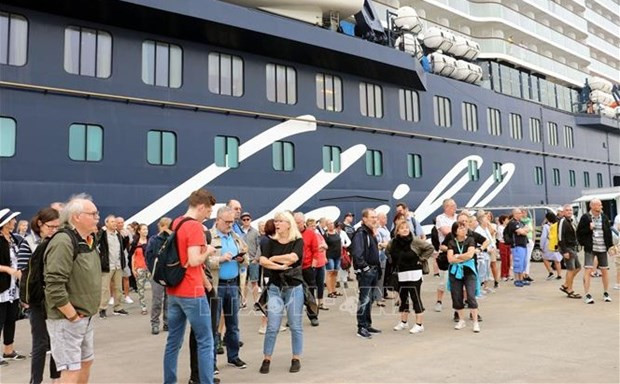
Foreign tourists at the Ha Long International Cruise Port. (Photo: VNA)
According to the UN World Tourism Organization, sea tourism generates revenue over 40% higher than air or land travel. However, this niche market requires suitable measures for efficient exploitation.
Nguyen Huyen Anh, Deputy Director of the Department of Tourism of Quang Ninh – which houses the UNESCO world heritage site Ha Long Bay, stated that as the sea tourism season unfolds this year, the northern coastal province has been continuously receiving high-end international cruise ships with thousands aboard. Particularly noteworthy was the simultaneous New Year arrival in Ha Long of the Portuguese-flagged Vasco Da Gama carrying nearly 650 German tourists and the Celebrity Solstice of Maltese nationality with 3,000 visitors.
Meanwhile, the central coastal city of Da Nang, which hosted 22 ships with over 18,000 passengers onboard last year, has anticipated welcoming 45 liners with over 40,000 passengers for this year. Most recently, over 2,000 passengers on the Westerdam arrived at the local Tien Sa port to celebrate the New Year.
Travel agencies stressed that Vietnam's extensive coastline, featuring destinations along vital maritime routes in Asia, positions the country ideally for connecting sea tourism routes regionally and globally. There is a significant opportunity for Vietnam to become a hub for sea tourism in the future. However, attracting and retaining this type of travelers for an extended duration remains a challenging task.
Many travel experts pointed out that Vietnam’s large and upscale stores and shopping centres still fall in the mid-range compared to regional peers and have yet to fully capture the attention of international visitors, especially those with big pockets. According to estimates from Phan Xuan Anh, head of the Tan Hong - Du Ngoan Viet Company – a specialist in the field, sea tourists spend around 100 USD per person during their time onshore of between 8 and 11 hours.
Nguyen Anh Tuan, Director of the Institute for Tourism Development Research, emphasised that international sea voyages not only are a leverage to rejuvenate the market but also affirm the high-end tourism brand of the destination. Characteristics of marine passengers include a large group size and a short visiting time at each destination, hence a need for quick, precise, and safe organisational operations.
In reality, not many businesses are capable of providing services for the group, and the quality of related reception services is restricted. In the long run, localities need to continue improving service quality, focusing on developing luxury tourism products, and implementing plans for supplementary training to ensure an adequate workforce./.VNA